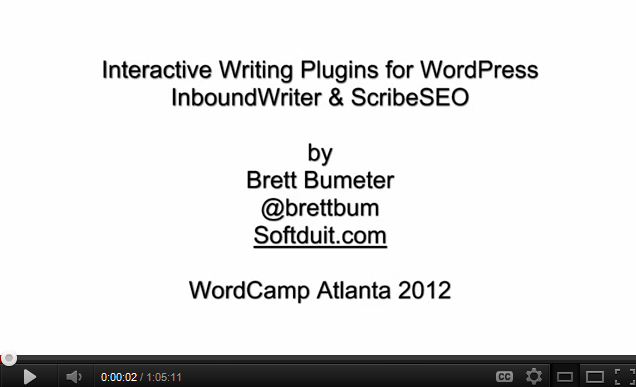Interactive Writing Tools at WordCamp Atlanta
This year I’m speaking at WordCamp Atlanta about Interactive Writing tools or in WordPress speak ‘Interactive Writing plugins’. In particular I am covering two plugins, a plug-in that I discovered in 2010 and another plug-in that I discovered at the end of2011. The first plug-in is Scribe SEO and the second plug-in is something called InboundWriter. Both plug-ins are considered to be premium plug-ins. A premium plug-in is a plug-in that you have to pay something for as opposed to a plug-in that is free. Scribe SEO does come in the form of a plug-in that you can simply install your website, but you can’t use it unless you pay for the Scribe SEO service. I have been a paying customer since 2010. It’s a monthly subscription that I pay for and it is well worth the money. I typically pay about $27 a month.
When I first started using it, they offered a free trial for a month and then you could upgrade to the paid version.
InboundWriter works a little bit different. They have something called a freemium model. Under this pricing model, you can receive some other services for free, and if you want more the services you can pay for that. I’ll explain it more in just a second.
Interactive Writing Tools Analyze what and how you are writing and give you guidance to make it more EFFECTIVE
Both both interactive writing tools basically work to analyze what you write on a WordPress post or on a WordPress page.
The services and their paid components kick in at this point of analysis and a measure what an analysis is slightly differently. Scribe SEO gives you an analyze button, and every time you push that analyze button they track it and did talked an evaluation from your account. Evaluations are kind like cell phone nets. Through your subscription you get X number of evaluations every month. So you can hit the analyze button X number of times during the month until your evaluations count down to zero. The evaluation reviews everything that you’ve written on a post page within WordPress plus it looks at your WordPress title, and your SEO description field and your SEO title, it requires that you use some form of SEO plug-in or SEO powered theme like StudioPress. There are a number of areas that it analyzes in it then returns a number score the form of a percentage, you can kind of think like a numerical grade that you might have received in school. A 70% would be okay but not so great, and 85% would be kind of like a ‘B’, and when you get into the 90th percentile you are in ‘A’ territory.
It has been my experience that when you get into the 90thpercentile, this means that you’ve written an article and you vandalized it and you’ve tweaked it until you scored very well, odds are you’re going to have an article that will perform very well in the search engines.
Ranking for the wrong keywords in Google vs Ranking for the RIGHT keywords
Do something even more important than ranking well the search engines, and that’s ranking well for the right words. You can rank all day long for words that aren’t about the article that you’ve written, and if people come to your site and don’t find what they’re looking for, they’re going to bounce away. Eventually Google will seek its revenge on you for sending its people to the wrong place. In a whitehat type of way, Scribe SEO helps you bring the right people to the right place on the right keywords. You will find that this also helps you understand the demographic of people are coming to your site. When you know why people are coming to your site, it helps you communicate with them even more effectively.
To put it simply, it helps your website and you pages become more effective in this can make you more successful as a blogger or as a website owner.
There’s another small but important thing that it helps you do. It helps you write and rewrite your description and titles to help entice people to actually click on your link if they see your article listed in a Google search. This is a very important selling aspect for your website. It does you very little good to be number one in Google, if someone performs a search and seize a better fit in the number two slot and clicks that instead of your link.
InboundWriter works a little differently. It is not so much a tool for search engine optimization, is it is a tool to help you write a better article in the first place and target the audience that your writing that article for.
From a pricing perspective they don’t use the evaluations like cell phone minutes type of business model. Instead they let you review a blog article or a page over and over and over again as many times as you want, up to eight blog articles or pages per month that is under their free plan. If you want to review more than eight articles per month, then you have to upgrade to their premium service which costs $20 a month.
This is a little bit simpler there aren’t as many other pricing levels and service types, which makes it easier to buy frankly. $20 is all that much money it’s not free but you can get it for free if you want. Using InboundWriter to review eight blog articles per month is actually pretty good deal. It’s free first of all, and you can get a lot of value out of reviewing that many articles per month. Many small businesses and other bloggers don’t write too many more articles that a month anyway. For those sites and companies and people that write more the unlimited plan for $20 might be a better deal.
InboundWriter brings interactivity into the mix as well. As you write it automatically adjusts to what you’re writing, the words that you are typing and its scores and rescore send updates the score which are doing as you do it. It provides immediate feedback on a number of items in this helps you zero in on what you’re writing while you do it so that you don’t get off on a tangent if you don’t intend to get off on a tangent as I have in this particular article.
There’s a speed dial that looks a little bit like a speedometer. In this provides you with a score which is again on hundred point scale. It is a lot more difficult to score in the 90th percentile using InboundWriter as compared to Scribe SEO.
It also allows you to change the priority of the metrics that’s used for the scoring system. I’ll explain that in more detail. There are many factors that looks at when it scores what you write and SEO really isn’t one of them. It looks at what level of writing your writing at for example are you writing towards an audience with the general level of education or an audience of PhD’s. There have been many plug-ins that do a similar thing, but this particular review is built into this plug-in with a number of other features. After you select the level of education of your potential audience, you can then also select how popular the topic is that you’re writing about from the perspective of a couple different sources. One of those sources is AdWords from Google. It looks at search items from that program and helps you identify what topics are trending and advertising from an AdWords or Adsense payout perspective. Alternatively if you not concerned about advertising due Google system and how much it might pay to have an ad on your site as its tied into the topic that you’ve written about, you can also just look at how popular the topic is how many people are looking for the keywords that you’re writing about on the Internet. InboundWriter allows you to pick a number of different topics and did it analyze whether or not you are covering those topics well within your love article. If you’re not covering it well enough, your score will be lower. If you’re covering your main topics very well your score goes up.
Compared to scribe, this is another difference is scribe tends to focus on a single primary keyword in your writing. I should also point out that scribe is in version 3.0 currently in InboundWriter is in beta. Scribe will be coming out with an imminent upgrade sometime this year do have a firm date on it because I don’t work for them. InboundWriter which is in beta is changing and upgrading quite a bit right now. I mention this because what I cover now is likely going to change in both cases. I’m expecting something of a major overhaul for scribe and I’m expecting lots of iterative improvements for InboundWriter.
See the Screencast version of my presentation on Interactive Writing Tools at WordCamp Atlanta
*Note The full presentation will be available on WordPress.tv eventually. I recorded the audio and my own demo screen for this.

